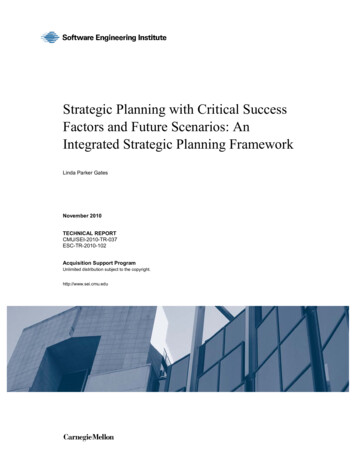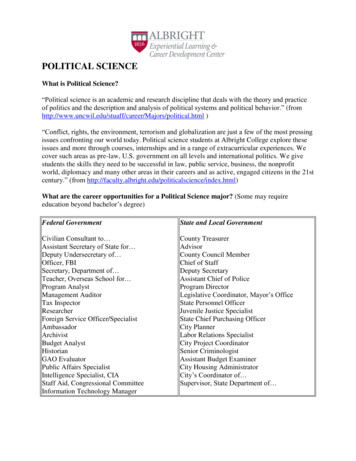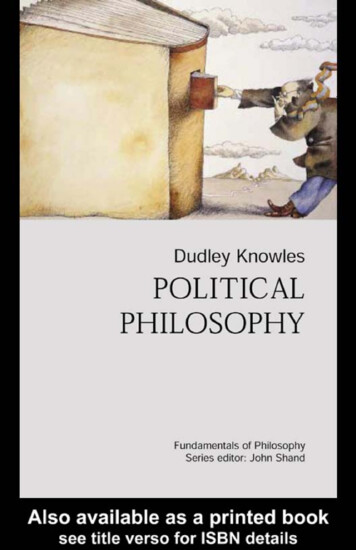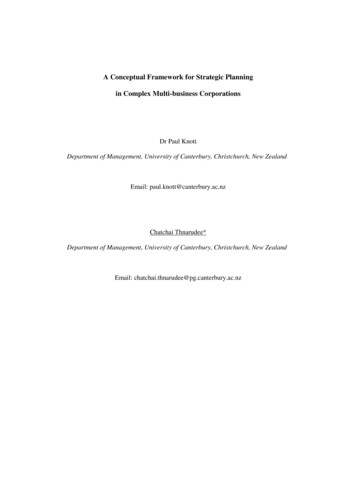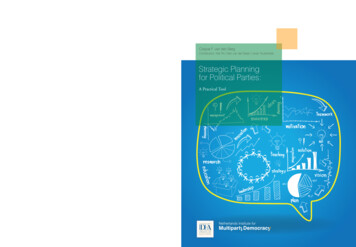
Transcription
Caspar F. van den BergContributors: Kati Piri / Sam van der Staak / Levan TsutskiridzeThis publication aims to provide a practical tool to help political parties conductstrategic planning, and offers assistance providers and political parties alike astep-by-step methodology for conducting this planning process.International IDEANIMDStrömsborgPassage 31S-103 34 Stockholm2511 AB The HagueSwedenThe NetherlandsT 46 8 698 37 00T 31 (0)70 311 54 64F 46 8 20 24 22F 31 (0)70 311 54 rgStrategic Planning for Political PartiesPolitical parties are too often forced to focus on short-term external crises to thedetriment of the medium and long-term development of their strategies and theinternal organization to support these strategies. This tool helps political partiesaddress this issue by focusing on the importance of strategic planning as a meansfor strengthening their capacity to engage in organizational learning and respondto changing circumstances.Strategic Planningfor Political Parties:A Practical Tool
About the AuthorsInternational IDEAThe International Institute for Democracy andElectoral Assistance (International IDEA) is an inter govern mental organization that supports sustainabledemocracy worldwide. Its primary mission is tosupport sustainable democratic change by providingcomparative knowledge, assisting in democraticreform and influencing policies and politics. Inparti cular, this includes convening political dialogueon democratic change at the request of nationalactors. The Institute aims to ensure that democraticoutcomes are consistent with full and equal politicalparticipation and representation of women and men;are inclusive with regard to the many expressions ofdiversity in society; and minimize conflict and consolidate peace and security. The Institute’s work onpolitical parties takes place under the framework ofan institution-wide programme on Political Parties,Participation and Representation and focuses onimproving the credibility, effectiveness and deliverycapacity of political parties. More information canbe found on its website: www.idea.intNetherlands Institute for Multiparty DemocracyThe Netherlands Institute for Multiparty Democracy(NIMD) is a democracy assistance organizationestablished by political parties in the Netherlandsto support political parties in young democracies.NIMD specifically provides assistance to processesof dialogue between political parties in programmecountries, the institutional development of parlia mentary parties, and networks of cooperationbetween political and civil society. NIMD adheresto strict principles of ownership, neutrality andtransparency, and acknowledges that democraciesare homegrown.NIMD has provided support in context-specificways and at the request of its partners in constitutional-reform processes in countries such as Bolivia,Ecuador, Ghana, Kenya, Malawi, Tanzania, Zambiaand Zimbabwe. More information can be found onits website: www.nimd.orgCaspar van den Berg is a lecturer and researcher atLeiden University’s Centre for Public Sector Reform.His has written three books and numerous articlesin international academic journals on strategicpublic management and program management,administrative reform, and political-administrativerelations. In previous positions, Caspar worked asa public management consultant for Berenschot,where has designed and implemented projects formany Dutch ministries, provincial governmentsand executive agencies. His prize winning PhDdissertation (2011) examines the impact of Euro pean integration on politics and bureaucracy in threeEU member states. Since 2003, Caspar has beeninvolved with the Prof.mr.B.M. Teldersstichting,the think tank of the Dutch Liberal Party VVD,as a contributing author and member of the Boardof Editors of its journal, Liberaal, Liberaal Reveil.Kati Piri works for the Netherlands Institute forMultiparty Democracy (NIMD) as programmemanager for the South Caucasus and Moldova.Her expertise lies in the fields of EU and foreignaffairs, democratization processes and strengtheningpolitical parties. Prior to joining NIMD, Katiworked for six years as foreign affairs and security& defence advisor in the European Parliament.She obtained her Master’s degree in InternationalRelations at the University of Groningen.Sam van der Staak heads International IDEA’sPolitical Parties team. He has worked with politicalparties in countries such as Kenya, Mongolia,Burundi, Zimbabwe, Georgia and Afghanistan.In addition to his work on the organizationaldevelopment of political parties, Sam researchespolitical party dialogue and the impact of moneyon politics. He has advised legislators in the areas ofpolitical finance and political party law. Prior to hisinvolvement in democracy assistance, Sam workedat the Netherlands House of Representatives.Levan Tsutskiridze works as the NIMDRepresentative in the South Caucasus. Beforehe joined the NIMD, Levan worked as the Rectorof the Georgian Institute of Public Affairs (GIPA).Earlier, he was the Project Manager for the reformof the Georgian civil registration system.In his earlier career, Levan served at the OSCEand with Open Society Foundation in Georgia.Levan Tsutskiridze graduated from the JohnsHopkins University Paul H. Nitze School ofAdvanced International Studies (SAIS). Hisresearch and professional interests are in foreignand security affairs, political institution buildingand democratic development.
International IDEA / NIMDStrategic Planning for Political Parties:A Practical Tool
International IDEA / NIMDStrategic Planning for Political Parties:A Practical ToolCaspar F. van den BergContributors: Kati Piri / Sam van der Staak / Levan Tsutskiridze3
4Strategic Planning ToolContentsPreface8Acknowledgements101 Introduction131314151.1 The benefits of strategic planning for political parties1.2 Audience1.3 Structure of the planning tool2 Strategic planning for political parties in context2.1 Organizational action in a changing environment2.2 What exactly is strategy?2.3 The evolution of strategic planning and management2.4 Assistance providers and parties in young democracies2.5 Conclusion3 Phase I: Initiating and designing the planning process3.1 The assistance provider as process facilitator3.2 Local preparatory activities3.2.1 Participation and inclusiveness3.2.2 The role and selection of consultants3.2.3 The composition of the working group3.2.4 Readiness assessment3.2.5 Agreement on process and planning3.2.6 Baseline analysis4 Phase II: Internal and external analysis4.1 Developing a party’s organizational vision4.2 Stakeholder analysis4.3 Mission and values4.4 SWOT analysis5 Phase III: Drafting the plan5.1 Identifying and assessing the strategic issues5.2 Formulating strategies5.3 Reviewing and adopting the strategic 41
International IDEA / NIMD6 Phase IV: Towards implementation and evaluation437 Strategic planning in Georgia (2010–2011) and Mozambique (2012)474748484950517.1 Objectives and motivation7.2 Timing7.3 Process7.4 External experts7.5 Strategic planning working groups7.6 MethodologyAnnexesAnnex I: From generic tool to country-specific manualAnnex II: WorksheetsAnnex III: Activities and workloadAnnex IV: Interview guidelines for post-planning meetings5354557981Acronyms and abbreviations82References83Colophon845
6Strategic Planning ToolBoxes, tables and figuresBoxesBox 4.1 The vision of a Georgian political partyBox 4.2 Checklist for a political party’s strengths and weaknessesBox 4.3 Example: the African National CongressBox 5.1 The key strategic issues of a Georgian political partyBox 5.2 Example: the Australian Labor PartyBox 6.1 Example: Peru and the Alianza Popular Revolucionaria Americana (APRA)323538404244TablesTable 2.1 Various kinds of organizational actionTable 2.2 Basic strategic concepts in the private and public sectorsTable 4.1 Questions as starting points for the SWOT analysisTable 4.2 A SWOT analysis by one of the Georgian political parties17213637FiguresFigure 1.1 The democratic and civil roles of political partiesFigure 2.1 Different levels of organizational actionFigure 2.2 The evolution of thinking about strategic planning in the private sectorFigure 2.3 Strategic planning and strategic management as public value creationFigure 2.4 Four phases of strategic planning for political partiesFigure 3.1 Phase I activitiesFigure 4.1 Phase II activitiesFigure 4.2 Power versus interest gridFigure 4.3 The relationship between a party’s political-ideological and organizational missionsFigure 5.1 Phase III activitiesFigure 7.1 The organizational structure of the programme1519202223263133343950
8Strategic Planning ToolPreface1 ChapterIt is a paradox: political parties have the ambitionto govern states, but they are often poorly governed themselves. There is a constant tension indemocratic politics between the short-term need torespond to the electorate and the development oflong-term goals and strategies.Political parties, in particular, are too often forced tofocus on short-term external crises to the detrimentof the medium and long-term development of theirstrategies and the internal organizations to supportthese strategies. Especially in young democracies,this tends to weaken political parties’ prospectsfor survival in often rapidly changing political landscapes. In turn, it also tends to weaken public trustin political parties as a vehicle for representationand governance. Only by having the capacity tolook ahead and anticipate developments can political parties prepare themselves adequately for newsocietal demands and democratic changes.This publication provides a practical tool to help political parties conduct strategic planning and offersassistance providers and political parties alike astep-by-step methodology for conducting this planning process. If political parties want to prepare adequately for tomorrow’s political developments, theyhave to invest in their organization and its foundations. Doing so is only possible if the political party’sorganizational structure and processes adequatelyreflect the rapidly changing political landscape thatsurrounds it. This means regularly analysing surroundings and adapting to new developments usingbroad input from within the party.Around the world, we see that it is possible for political parties to reinvent themselves and be sustainable. The repeated prediction in previous decades ofthe downfall of the political party as the main body
International IDEA / NIMDfor participation and representation in democracieshas thus far been proven wrong. Political partiesfrom Argentina to South Africa and Australia havenow passed their centenary anniversaries, an agethat only a handful of companies or other privateorganizations on their continents can match.At the same time, that which does not evolve willwither and die, and political parties do need toadapt and change to meet the needs of citizens.The recent emergence of citizen-led protest movements in all parts of the world, from Egypt to Chileand Thailand, has challenged political parties tofind new ways of representing people, lest they bereplaced by more direct methods of democraticparticipation. New forms of technology such associal media, which facilitate citizens’ expression ofpolitical opinions, may also pose a challenge to political parties that cannot see the need to adapt theirways of working.This Strategic Planning Tool for Political Parties is acontribution that parties around the world can usein their attempts to further gain the interest and trustof citizens. In this tool, which was first successfullytested by the Netherlands Institute for MultipartyDemocracy (NIMD) in its programmes in Georgiaand Mozambique, we hope that political parties willfind a resource to improve their public standing aswell as their chances at electoral success. Moreover, the tool’s succinct and practical approach toplanning—making use of worksheets and a clearstep-by-step set-up—is aimed specifically to makeit easier for politicians to engage in planning in thebusy world of politics.In late 2011, International IDEA and NIMD signeda strategic partnership agreement, intending to increase cooperation in all areas of their work. Sincethen, both organizations have set out to producea range of joint publications in, among others, thearea of political parties. After a publication on Constitutional Reform Processes and Political Parties in2012 and now the Strategic Planning Tool for Political Parties, joint publications will follow in 2013 dealing with political party dialogue and political finance.Hans BruningExecutive DirectorNIMDVidar HelgesenSecretary-GeneralInternational IDEA9
10Strategic Planning ToolAcknowledgementsCreating this tool would not have been possiblewithout the support and contributions of numerousindividuals and organizations.Special acknowledgement goes to the lead author,Caspar van den Berg. We also gratefully acknowledge the input of the other contributors: Kati Piri,Sam van der Staak and Levan Tsutskiridze. Additional thanks goes to Ann Tsurtsumia and Hermenegildo Mulhovo for their research support.Special thanks also goes to the political parties thatparticipated in the piloting of this strategic planningtool. For Georgia: the Christian Democratic Movement, Georgia’s Way, the Labour Party of Georgia,the New Rights Party of Georgia, Our Georgia– Free Democrats Party, the Republican Party ofGeorgia and the United National Movement. ForMozambique: Frelimo, the Mozambican DemocraticMovement and Renamo.We also extend our appreciation to Javier Barreda,Anne-Mieke van Breukelen, Luis Egúsquiza, JorgeValladares and Peter Yates for their important inputsto the country cases.We thank our peer reviewers, Martin Ängeby,Andrew Ellis, Elin Falguera, Brechtje Kemp, RaulAvila Ortiz, Pepijn Gerrits, Hanne Lund Madsenand Percy Medina Masías, for their comprehensivework and expert guidance. Finally, we are gratefulto Nadia Handal Zander of the publications team ofInternational IDEA, and to Marieke Hoornweg of thecommunications team at NIMD for coordinating theproduction of this publication.
12Strategic Planning Tool
International IDEA / NIMD1 IntroductionThis tool is intended to guide political party assistance providers in helping political parties set up andcarry out strategic planning processes. It offers anapproach to, and guidelines for, the practice of strategic planning aimed at systematically strengtheningparties’ organizational capacities. We treat electoralcampaigning strategy as one aspect of a party’sorganizational functioning, but by no means as thecore issue in organizational strategic planning.Our key principles in developing this tool have beenco-ownership of the tool between political partiesand assistance providers and a strong focus onthe local circumstances, institutional structures andcultural aspects of the political system in question.Importantly, the planning process itself—and its outcome—are fully owned by the political parties thatconduct and undergo the planning exercise. Thetool has been developed on the basis of existinginsights from the literature on organizational strategic planning for non-profit organizations, practicalexperience with strategic planning processes in several countries (primarily Georgia and Mozambique)and with the input of a broad group of practitionersand other experts from leading international assistance providers. This publication makes referencepredominantly to cases in which the tool has beenused by an assistance provider that supports multiple parties at the same time. However, organizationsthat work with only one party, or a selected part ofthe political spectrum, are considered an equallyimportant target audience. Virtually all the tool’selements are relevant and useful to assistance providers that have either a multiparty or party-to-partyapproach. Therefore, where the tool uses the plural‘parties’, it can often be replaced by the singular‘party’ for those using a bilateral approach.In the remainder of this chapter, we address theimportance of strategic planning for political parties,the tool’s audience and the organization of thispublication.1.1 Thebenefits of strategic planning forpolitical partiesPolitical parties in any political system typically findthemselves in a complex and uncertain environment. Change is a constant within all parties andparty organizations, and in their external surroundings. New individuals take up positions among theleadership, cadres and back office, and othersleave. Budgets change, sometimes for the better,sometimes for the worse. Changes may be madeto the constitutional arrangements, legislation andother types of regulation concerning the politicalprocess and political parties. The expectations ofthe electorate as a whole (or of specific constituencies) may change, and the electorate may change,for instance, as a consequence of demographicdevelopments. Economic turmoil and domestic andinternational policy challenges may either suddenlyor gradually confront the party with new issues.Competing parties may rise or decline. Parties maysplit, merge or find other groups or individuals withwhich to collaborate.Such changes and challenges can either strengthenor weaken a party, and can either contribute to therealization of the party’s goals, have little impact orjeopardize the party’s continuity. In order for partiesto be successful in such an environment, focus,determination and adaptive institutional capacityare required. It is vital for a political party, includingthe party organization, to have a shared idea andpicture of what the party is, where it wants to goand how it plans to get there. This tool is designedto offer the mechanisms to develop these sharedvisions.13
14Strategic Planning ToolStrategic planning offers political parties the opportunity to step back from their day-to-day activitiesand worries to reflect on more fundamental andlong-term issues. It also provides an approach forsetting realistic long-term objectives for repairing,maintaining or enhancing their institutional strength.From a process point of view, engaging in strategicplanning helps increase internal debate and ideaformation and unites members around commonobjectives. As a result, priorities for institutionalstrengthening can be identified, strategies to moveforward can be formulated and benchmarks for progress can be established. In short, strategic planning helps political parties define where they want tobe and what kind of action agenda is necessary tostrengthen their institutional capacity in the future.Strategic planning and enhanced institutional capacity offer clear benefits to political parties.1. The party and the party organization can enhance their performance and respond morequickly (and more successfully) to changingcircumstances. Clearer insights into a party’sstrengths, weaknesses and priorities allow it toachieve better results using fewer resources. Inthis context, better results do not mean betterelectoral results, but achieving organizationalgoals such as stable or increased levels offunding, enhanced capacity to organize partycongresses, more effective and efficient waysof selecting candidates, and better training programmes for party members.2. A strategic attitude can also enhance understanding and the capacity for organizational learning.This leads to more conscious, more disciplinedand better-informed methods of self-analysis anddecision making. Finally, planning can improve external communications and societal and politicalsupport, because it helps a party communicateits core ideas and objectives more effectively—making it more recognizable and creating a morepositive, consistent and confident public image.Strategic planning is equally relevant from the perspective of political party assistance providers.1. Strengthening parties’ institutional capacity—typically the mission of assistance providers—is more likely to succeed, and is morelikely to take place in a focused way, if thepolitical party has developed an organizationalmission. Strategic management as a tool for political parties involves formulating a mission andfollowing up to fulfil that mission. For the partiesthat assistance providers work with, strategicplanning can help improve their positioning visà-vis their external environment and their performance in their internal environment.2. A longer planning time frame makes it easierfor assistance providers to programme andorganize their support to political parties,and to work together with other assistanceproviders. A long-term strategic plan extendsthe time frame of their partner parties’ objectivesand planning, and is therefore more realistic andeffective than one-off projects and funding. Asound strategic plan will lead to identifiable projects for the medium and longer term, and suchplans may function as a framework for projectproposals for which the assistance provider can,in turn, make funding or other types of assistance available.3. Support to strategic planning can be equallysuccessful when carried out with a single ormultiple political parties at the same time.However, an inclusive strategic planning process, in which multiple political parties take partindividually, helps identify possible joint challenges to both institutional capacity building andthe democratic system in question. As such, ata more macro level, strategic planning will helpassistance providers identify priorities and determine their future focus areas.1.2AudienceThis tool was primarily developed for use by assistance providers working with political parties inemerging democracies. Below, they will find detailsof theory and practice, as well as recommendationson the entire process of strategic planning: processdesign and initiation, internal and external analyses,drafting the plan, and the implementation process.The tool considers issues such as securing theinitial (and sustained) commitment of the politicalparties being assisted. Assistance providers—and,where relevant, their local implementing partnerorganizations—will find the tool a useful means ofinitiating and coordinating the planning process.Although political parties may not be the primaryaudience of this publication, they are its central
IntroductionInternational IDEA / NIMDactors and core beneficiaries. They will take theactions, implement the plans and reap the benefits.Therefore demand from and buy-in on the part of, thepolitical parties is essential for the planning processto succeed.In addition to assistance providers, this publication istargeted directly towards any other interested individuals or groups that want to learn more about strategic planning and strategic management in a politicalor politicized environment. Such individuals or groupsinteract with political parties, but are not direct beneficiaries of the process of strategic planning forpolitical parties. They may include people affiliatedwith non-governmental organizations (NGOs), donororganizations and various kinds of public institutions.The tool is relatively generic, so it can be used as astarting point in all parts of the world. However, giventhe importance of (a) language and (b) the institutional structure, political-legal arrangements and cultureof each country, the tool should be transposed andtailored to the specific setting in which the politicalparties operate. This transposition exercise shouldideally be carried out by experts from the country.Annex I gives pointers on how to tailor the tool to agiven national setting.1.3Structure of the planning toolThe remainder of the publication is structured asfollows. Chapter 2 discusses the theory and generalbackground of the concept of strategic planning.It places strategic planning for political parties inthe wider context of strategic planning, and in thespecific context of providing assistance to politicalparties in young democracies. Chapter 2 may beconsidered optional reading; those with a broad interest in strategic planning will find it useful, whereasreaders with a specific practical focus may choose toproceed directly to the practical parts, which beginwith Chapter 3.Chapters 3 to 6 describe the tool step by step. Thispart sets out the various phases of the strategicplanning process for political parties: designing andinitiating the process, internal and external factors,drafting the plan and the steps towards implementation. The methodology used for these sectionsis based on the model used by Bryson and Alston(2011). Chapter 7 gives an account of the strategicplanning programme carried out by the NetherlandsInstitute for Multiparty Democracy (NIMD) with sevenpolitical parties in Georgia from 2010–11 and withthree parties in Mozambique in 2012. This chaptersketches out the activities, practicalities and experiences that can form part of a programme that usesthis tool. Annex I presents guidelines for transposingthe generic tool to a country-specific tool. Annex II*contains a series of worksheets that support each ofthe phases using practical questions and activities.Annex III lists the costs and managerial issues thatshould be taken into account in a strategic planningprogramme. Annex IV provides interview guidelinesfor post-planning meetings.Figure 1.1Types of audiences for the Strategic Planning Tool1Assistance providersas initiators/facilitators2Political parties asusers/implementers3Other interested actors asindirect benefactors/observers* The worksheets included in this Annex are inspired by (and based on) the worksheets in John M. Bryson and Farnum K. Alston, Creating your Strategic Plan,Third Edition. Copyright 2011 by John Wiley & Sons, Inc. All rights reserved.15
16Strategic Planning Tool
International IDEA / NIMD2 Strategic planning for political partiesin context2.1 Organizationalenvironmentaction in a changingThe previous chapter described the continuouslychanging—and often challenging—political, legal,societal and economic environment in which political party organizations may find themselves. Thatenvironment is likely to affect the party’s internaland external spheres, and thus the degree to whichit can achieve its aims. Managing these issues effectively may increase the party’s ability to achieveits goals. If such issues are either not addressed orineffectively addressed, the consequences couldbe dire.There are different ways in which a political partyorganization can relate to actual and anticipatedchange. In some cases, the organization automatically evolves in response to environmental changeswithout any conscious action—and without anyinfluence over the outcome of the change. Such ashift may later be evaluated as detrimental to the organization’s capacity to achieve its goals; or, worse,it may herald the end of that political party. In thiscase, the party has, in a very real sense, becomethe plaything of external actors and circumstances.At the other end of this spectrum, the party organization may take charge of its own destiny by activelyscanning its environment in an attempt to anticipateenvironmental change. Between these two extremes, we can place (1) adaptive action, in whichthe party recognizes environmental change andmakes incremental adaptations to cope with it; and(2) reactive action, in which the party is affected bythe implications of unforeseen change, is perhapsthrown into crisis and changes in response. Table2.1 presents the spectrum of ways in which a political party may relate to environmental change. Thiscontinuum departs from the idea that the higherthe degree of anticipation, the greater the capacityto adjust in a timely and effective way, taking theparty’s future into its own hands and enhancing itscapabilities in the future.It is the task of party leaders and managers (i.e.,political figureheads as well as heads of the partyorganization) to effectively steer their party throughthe inherent complexity and uncertainty of their environment. The underlying assumption of this tool isthat leaders and managers are best able to do thiseffectively if they act based on a carefully developedstrategic plan that has come about using a dialogicprocess of internal and external analysis, plan drafting and implementation. By dialogic we mean that,to an important degree, the involvement of relevantTable 2.1Various kinds of organizational actionProactive actionAdaptive actionReactive actionEnvironmentallydetermined changeActively scan environment; anticipate environmental changeRecognize environmentalchange; make incrementalchange to copeHit by implications of unforeseen change; experience crisis;change in responseAutomatic change in responseto environmental change; noinfluence over outcome17
18Strategic Planning Toolinternal stakeholders determines the success of theprocess.The tool presented in this book offers assistanceproviders and political parties the practical instruments they need to anticipate changes and designand implement effective strategies to address thosechanges. This tool gives parties the opportunity totake charge of their internal performance and external positioning. More concretely, it involves planningand acting more consciously, coherently and effectively, so that continuity is improved and long-termresults are more likely to be achieved.2.2What exactly is strategy?The term ‘strategy’ is used in connection with politicalparties in multiple ways. Perhaps the first that comesto mind is a party’s strategy to maximize its votes inan election. In this sense, strategy is closely relatedto campaigning; that is, reaching the electorate andconvincing as many voters as possible to vote forparty X. While this is certainly a crucial strategic aspect of any political party, it is not the type of strategyprimarily addressed by this tool. The focus of this toolis on organizational strategy rather than campaigningst
Figure 2.2 The evolution of thinking about strategic planning in the private sector 20 Figure 2.3 Strategic planning and strategic management as public value creation 22 Figure 2.4 Four phases of strategic planning for political parties 23 Figure 3.1 Phase I activities 26 Figure 4.1 Phase II activities 31 Figure 4.2 Power versus interest grid 33

